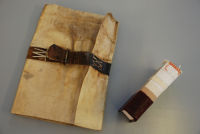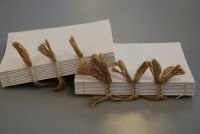 One of our conservators, Jeff Dowse, began his career in conservation by learning bookbinding skills. Here he describes some key bookbinding developments and techniques over the centuries.
One of our conservators, Jeff Dowse, began his career in conservation by learning bookbinding skills. Here he describes some key bookbinding developments and techniques over the centuries.
The origins of the book as we know it can be traced back to the Roman Empire of the first century and, over succeeding centuries, the papyrus rolls which had commonly been used up to then slowly dwindled. Parchment came to replace papyrus as it could be folded and sewn together, making an altogether more convenient and compact flat book, or 'codex'. Early codices were made using wooden boards covered with a cured skin, and even deer and seal skins were utilised. At this time, a method of binding was used, known as limp binding, which comprised a flexible cover usually made of vellum where the written sections were sewn to leather blocks and twists of parchment bound these through holes to the cover. The 'yapp' (an extension of the square cover seen on some limp bindings) can still be seen today on devotional books.
 By the fifteenth century, paper had been introduced into Europe, and flexible binding became the main method of construction for books. The sections of the book were sewn to thongs, which were laced into wooden boards. The leather cover was glued directly to the back of the sections resulting in a concave shape when the book was opened; and described as the 'flexible'. This process evolved over time, with cords replacing thongs, and pasteboard replacing wooden boards. At the same time, book cover decoration became much more elaborate, with gold tooling replacing earlier blind stamped designs.
By the fifteenth century, paper had been introduced into Europe, and flexible binding became the main method of construction for books. The sections of the book were sewn to thongs, which were laced into wooden boards. The leather cover was glued directly to the back of the sections resulting in a concave shape when the book was opened; and described as the 'flexible'. This process evolved over time, with cords replacing thongs, and pasteboard replacing wooden boards. At the same time, book cover decoration became much more elaborate, with gold tooling replacing earlier blind stamped designs.
The nineteenth century saw great changes as demand for books increased, with new manufacturing methods leading to the availability of cheaper materials. With lower quality materials and construction methods, a more robust book style was required. This led to the introduction of library binding, involving the use of a stronger board attachment, reinforced endpapers and sturdy covering materials, such as buckram. A recognisable feature of this process was an indentation at the spine edge of the book cover, known as the French groove, and later the Harrison Groove following its revival by Thomas Harrison after the Second World War. Another method was hollow back binding, first introduced into England in 1795, where the binding material moved freely from the spine when opening the book wide. Account register or ledger style with highly decorative covers of vellum and leather. And the library style covered in maroon buckram cloth featuring the french groove running down the spine edge of the board.
Alongside this development came account binding, an extremely hardwearing style for account registers, patented in 1799 by John and Joseph Williams. Using heavy-duty materials such as vellum and extra bands of leather, its significant feature was the spring action of the spine which threw up the text block so that the leaves rested flat. A major feature of account binding is book cover decorations with lacings of vellum and leather, and marbled edges to the text.
A development for smaller, cheaper books was case binding with the introduction of book cloth about 1825. Here, the covers were made separately from the sewn text block, the two joined by gluing the sewn on tapes, mull and endpapers to the inside of the book cloth-covered case. The arrival in 1890 of the Sheridan Casemaker speeded up this operation.
Another binding style perfected from the mid-nineteenth century was adhesive binding where single sheets of paper were given an adhesive coating – originally an India rubber-based glue - at the spine, rather than sewn together. This is known as caoutchouc or perfect binding. The style was designed for mass production but inevitably the rubber-based adhesives deteriorated and the books fell apart. This style can be seen in modern paperbacks where a variety of flexible adhesives are used but, even today, modern perfect bindings will not withstand heavy use.
In 2006, through Heritage Lottery Funding, we were able to conserve a number of volumes from the archives of the world-renowned piano makers, John Broadwood. 31 day books (also known as porter's books) dating from 1798 and their associated number books were rebound, many of which had suffered serious damage over the years from dampness and mould.

